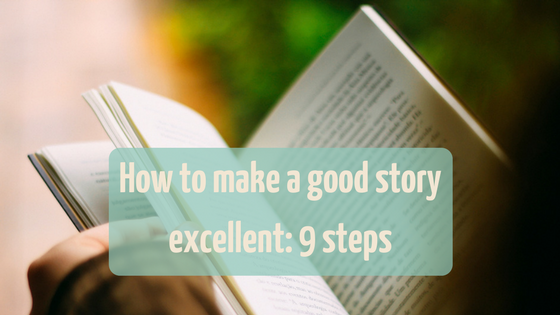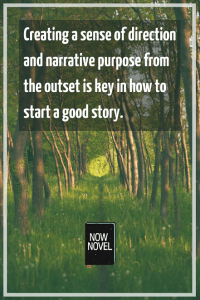Learning how to make a good story great requires mastering the essentials of writing craft: Plot (cause and effect), characterization, narration, description and dialogue. If you’ve written a good story but feel it could be more interesting, these 9 steps will help you transform it into a better first draft:
Step 1: Make your story’s beginning intriguing
A great story opening makes the reader invest quickly in finding out more. We’re often lured into stories by:
- Mystery (A murder happened. Why? A character is doing something unusual. Why?)
- The promise of change (A character is in a tough or wonderful situation, but there’s change on the horizon. What will happen?)
- A strong narrative voice (we quickly grow attached to a narrative voice that is full of personality, e.g. Scout in Harper Lee’s To Kill a Mockingbird)
Donna Tartt’s novel The Secret History is a ‘whydunnit’ (rather than ‘whodunnit’). From the first chapter we know there has been a murder, but we keep reading because we want to know why. Tartt’s opening paragraph has all three of the above-mentioned elements:
Does such a thing as ‘the fatal flaw,’ that showy dark crack running down the middle of a life, exist outside literature? I used to think it didn’t. Now I think it does. And I think that mine is this: a morbid longing for the picturesque at all costs.
Tartt introduces mystery from the start (You might ask, ‘What ‘fatal flaw’ is the narrator, Richard, referring to?’ What happened to change his perspective?). A story of change is promised in the sentences ‘I used to think it didn’t. Now I think it does.’ It’s clear we will find out why the narrator’s opinion changed if we read on. Tartt’s narrator comes across as a developed character with a world view and psychology of his own.
From the start, tantalize your reader with incomplete information. Convey your narrator’s personality as Tartt does in her portrait of the questioning, doubting Richard.
Step 2: Rewrite weak description and purposeless scenes
Learning how to tell a great story means learning how to make every page, every paragraph, every sentence count.
Great description does a lot of work: It builds mood and introduces a sense of possibility. For example, if you show your reader a character in a locked, bare room trying to escape, the reader can guess they are being held against their will without further explanation. Immediately, there is another ominous character (the key-holder) out of frame. There is potential for a tense and compelling dynamic between the two characters.
Strong description thus includes both what’s said and what Italo Calvino calls ‘the halo around what is said’; the possibilities that are created by a chosen set of constraints.
To make a good story great, rewrite descriptions that don’t do enough work. For example, in a story where a bomb has been planted on a train, your description of the train could suggest the danger of the environment even before the bomb is introduced:
It was rush hour, and the compartment was packed precariously full. At each stop, people spilled onto the platform. A woman opposite me exhaled loudly and gazed at the ceiling as though in prayer.
Creating a sense of direction and narrative purpose from the outset is key in how to start a good story. It’s key to every chapter, if you want your novel to grip readers from the first page to the last.
Rewrite or cut scenes that don’t add a further step towards your characters’ primary goals or introduce impediments to their progress. Every chapter should give the reader information that begs further questions.
Step 3: Give readers something to invest in every chapter
Giving information that makes readers invest a little more every chapter is key to making your book unputdownable. Scenarios that make us want to know the outcome include:
- Increasing tension between characters
- Increasing challenges standing in the way of characters’ goals
- Impending events that we know will be emotionally impactful (whether negatively or positively) for characters
Without this emotional element, a story is dry, the stakes inconsequential. Make sure that every chapter contains at least a little uncertainty to keep your reader curious.
Step 4: Show short-term and long-term cause and effect
A clear sense of cause and effect underlies every great story. Part of what made J.K. Rowling’s Harry Potter series a publishing phenomenon is how clearly Rowling shows cause and effect. For example, Harry’s presence at Hogwarts School of Witchcraft and Wizardry brings danger to the school’s grounds due to the threat he poses to the series’ villain.
To make your story exceptional, make sure its events are clearly connected. If your character decides to drop out of college in chapter 1, show the immediate result but also how this decision shapes them in conscious and unconscious ways. What doors will each action open and close? Clear cause and effect makes a story believable. It becomes easier to lose ourselves in the fictional world when we aren’t asking ‘would this really happen?’
Step 5: Describe characters with detail and complexity
Cause and effect is important when describing your characters. Great characters have history, psychology, and formative experiences. They have stories, sometimes false ones, they tell themselves. Believable fears, drives, aspirations and flaws. All the things that make us human. Read our in depth guides to describing characters and building believable character motivations.
Step 6: Ensure your dialogue flows and is engaging
Bad dialogue is where many stories fall down. The cardinal sins of writing dialogue include:
- Using dialogue to info dump (E.g. ‘As you know, Chris, we can use our special powers to get us out of this tight situation’)
- Using excessive dialogue tags (‘said’ and its descriptive alternatives)
- Making characters’ spoken voices virtually identical
To improve your story, make sure that each character’s voice in dialogue is distinctive. Are there particular expressions a character tends to use? Do they swear or hate swearing? Do they use slang or none at all?
Format dialogue well and combine dialogue with gesture, expression and narration to add descriptive colour to characters’ exchanges. Think of the script for a play: It includes not only what characters say but how they say it, where they are on the stage and what they’re doing.
Step 7: Avoid unnecessary words: Compress meaning
If you can say something in two words rather than five, do. Instead of ‘very small’, say ‘minute’, ‘tiny’, or ‘microscopic’. Concise, precise writing is easier to read and more vivid. ‘Very small’ is bland and literal, whereas ‘microscopic’ conjures, through metaphor, the image of looking at something so small it is usually invisible to the naked eye.
Read this guest post by Janice Hardy on how to cut words from a wordy manuscript for more advise on economical storytelling.
Step 8: Make sure subplots relate to your story’s major themes
Used well, subplots can make what is already a good story excellent. Subplots that seem irrelevant to your main story line will confuse readers, due to being seemingly irrelevant.
A good example of an effective subplot is the subplot concerning a young prostitute Sofia and her family in Crime and Punishment by Fyodor Dostoyevsky.
In Crime and Punishment, the protagonist Raskolnikov murders an old pawnbroker. He is also charitable to the prostitute Sofia and her family, giving them money for her drunkard father’s funeral even though Raskolnikov has little money himself. The subplot develops the novel’s themes of guilt and innocence. Raskolnikov’s kindness stops us from simply interpreting him as only guilty or ‘evil’. Although the character commits a terrible crime, the subplot allows us to see contradictory extremes within him: His darkest deeds alongside his noblest.
Dostoyevsky’s subplot encourages us to see the events of the story in their full circumstantial complexity. The subplot helps us see and feel empathy for the tragedy of characters’ situations and choices. It ensures that there is much more to the story than the crime and punishment of the title.
Step 9: Bring your story to a gripping climax and resolution
It’s easier to build to a good story climax when you build long-range cause and effect into your story. The event propelling the story towards the final confrontation between a protagonist and villain may be something that happened before the story even begins.
In Harry Potter, for example, Rowling uses her protagonist’s brush with the story’s villain (an event that occurred in infancy) to set further encounters in motion. It’s vital to maintain short-term (within scenes and chapters) as well as long-range narrative tension.
To master climaxes and resolutions, take notes on strong examples. Choose a novel that built to a satisfying conclusion. Note:
- What events the author describes throughout to build your expectation of a final confrontation or central climactic event (in a romance, for example, the moment the lovers kiss for the first time)
- On a timeline, plot the events that bring the characters closer to this significant event, and on another timeline, plot the story events that delay this moment
- How does the author prepare this climactic moment structurally. Are the preceding chapters shorter? Does the frequency or intensity of complications increase?
Think about how to apply other authors’ narrative techniques to your own writing because it will help you find a strong resolution.
Read this post on writing effective story endings for tips on how to draw your story to a close.
Get helpful feedback from other writers on Now Novel and use the idea finder to flesh out your story’s core themes and ideas.



